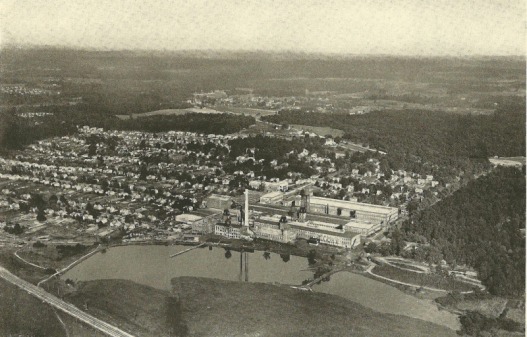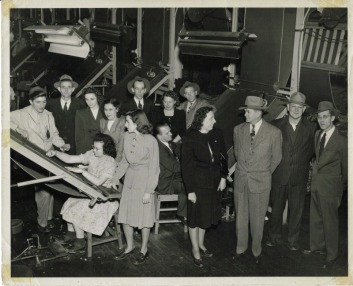What is a mill village?
Mill villages were company-owned towns, built from scratch by textile mills to house their factory workers and their families. In the early 1900s, Cone Mills Inc. built five villages to serve its Greensboro factories. These villages included churches, schools, ballfields, community centers, and company stores. Thousands of workers and their families made their lives in these “towns within a town” until the company began selling the houses (sometimes to workers) in the late 1940s.

Proximity Denim Mills and Village (Courtesy of Don Morrison)
History of Cone Mills

Class in Revolution Mill, 1940 (Courtesy of Kay Swofford)
Cone Mills was founded by brothers Moses and Ceasar Cone, grocery salesmen from Baltimore. They entered the textile manufacturing business after success with textile finishing ventures across North Carolina. They built their first textile plant on land northeast of Greensboro in 1896. The plant, Proximity Mill, a 200-loom denim factory, was named for its close location to the raw materials used in production. Over the next few years, the Cones encouraged their friends, the Sternberger brothers from South Carolina, to move to Greensboro and build another textile plant, Revolution Cotton Mill, which opened in 1898, producing flannel.[1] Eventually the Cones built two additional mills, the largest, White Oak Cotton Mill in 1905 and the Proximity Print Works, the first plant in the South devoted to dying fabrics, which opened in 1912.[2]
The company built self-sufficient villages for workers around each of the mills, containing churches, stores, schools, playing fields, recreation centers, and company-owned houses that were leased to mill workers. A separate mill village, East White Oak, housed African-American workers. The Cone mill villages at their peak covered 450 acres, with 2,675 workers residing in about fifteen hundred houses, before eventually being sold off during the late 1940s.[3] In recent decades, all the mills have shut down except for White Oak, which continues to make denim in Greensboro. After years of decline, Cone Mills Corporation, along with former competitor Burlington Industries, was bought out by International Textile Group, a take-over that began in the 1980s and was complete in 2004.
[1] Gayle Hicks Fripp, Greensboro Neighborhoods (Charleston, SC: Arcadia Publishing, 1998) 6.
[2] Marvin A. Brown, Greensboro Architectural Record: A Survey of the Historic and Architecturally Significant Structures of Greensboro, North Carolina (Greensboro, NC: Preservation Greensboro, Inc., 1995) 244-245.
[3] Howard E. Covington, Jr. Once Upon A City: Greensboro, North Carolina’s Second Century (Greensboro, NC: Greensboro Historical Museum, Inc., 2008) 43-44.

